Yoshitoshi ABe is, or at least should be, a pretty recognizable name. You’ve no doubt seen his work and influence across many series while watching anime. From the illustrations for the original novels of Welcome to the N.H.K. and All You Need Is Kill to providing original character designs for the technological horror series Texhnolyze and Serial Experiments Lain. ABe’s art has a distinctive, gritty quality to it that you don’t often see in modern Moe-fied anime. And for me that begs the question: What kind of stories is he trying to tell with this art? Well it seems we have our answer. Directed by Tomokazu Tokoro, animated by the now defunct studio Radix and created/storyboarded by Yoshitoshi ABe I give to you Haibane Renmei. So without further ado let’s talk about some cute angel girls within a not-so-cute story.
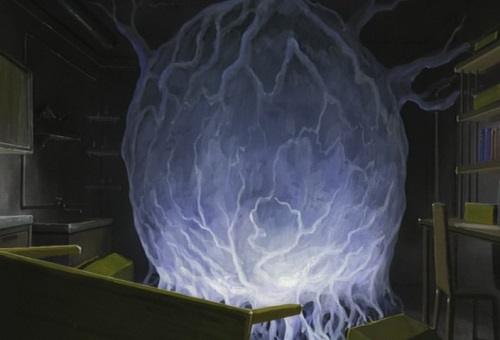
Visuals
Visually Haibane Renmei doesn’t stand out much. The designs, scenery and general aesthetic all come from the mind of Yoshitoshi ABe, giving it a very consistent aesthetic. In many series the lighter comedic scenes can be at odds with the heavier more emotional ones, leading to the viewer feeling like they are watching two different shows. Sometimes this happens because a series puts all the effort into battles, making them feel distinctly different from daily life, other times its because the production is simply an inconsistent mess. Luckily Haibane Renmei suffers from neither of these issues. There is a despair behind the comedy and a hope behind the despair that unites the two into a single consistent vision. And for a heavily thematic and picturesque work like Haibane Renmei that is incredibly important. Sadly though this comes at the cost of well… animation.
I wouldn’t say Haibane Renmei is a poorly animated show. Though only because that would imply it’s animated much at all. About 50% of Haibane Renmei is simple standing dialogue while another 40% is mostly basic movement ala walking or running. In addition to this many of the available video sources are rather blurry. And as for the remaining 10%? Well if I’m being honest that’s actually pretty good. When Haibane Renmei goes at a scene it goes hard. The problem is that it really only does so at the very start and end of the series. It strikes your interest early, pulls you in and gets you invested in the narrative, and then waits until the end for a grand payoff. In a way this might be the point. The scenes stand out so much that they make very strong impressions, lasting with you long after the series ends.
That said I wouldn’t necessarily call Haibane Renmei a bad looking show either. Earlier I described it as “picturesque” and you may have wondered what I meant by that. I use the word to mean series with evocative, striking and beautifully composed still images. Single frames packed with detail and emotion that stick in your mind. These are effectively postcard memories, though it’s not entirely accurate since Haibane Renmei doesn’t use the iconic pastel chalk style among other aspects. Still, I hope you get the idea. This is a series that thrives off of gorgeous and detailed backgrounds, good lighting and expressive composition. Now personally I tend to prefer the more kinetic and active style of animation since if the narrative isn’t engaging the visuals can still carry, see this seasons takt op.Destiny. Luckily however Haibane Renmei’s narrative is fantastic and the picturesque style fits it like a glove.
Speaking of narrative, lets talk about that!
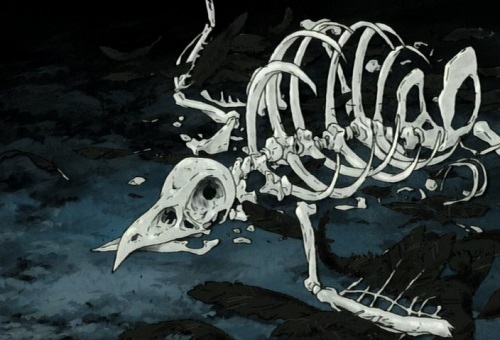
Narrative
To me this is easily the best part of Haibane Renmei but it also the most difficult to talk about. At least without spoilers that is, though I will save those for the end. At it’s core I believe Haibane Renmei to be a relatively simple story. One about learning to love and forgive yourself. About learning that its ok to ask for help and that depression doesn’t make your any less of a person. That you, the viewer, deserve to be happy. There are a lot of other themes and subjects tied into that of course. Haibane Renmei explores this idea through the lens of both community and religion, the benefits and problems of both plain to see. Yet because Haibane Renmei is such a character focused story neither of those dominate the narrative all that much. They are simply present, their effects felt through the characters.
Now if hearing that these themes are present and core parts of the narrative concerns you, I don’t blame you. Religion can be a very difficult topic to tackle with any kind of nuance. But I can say with confidence that Haibane Renmei does it well. I never felt like I was being preached at, that I was being told “Religion is [Insert Adjective]”. For example throughout the series our two leads interact with the local religion in two very different ways. One is constantly being uplifted and supported by it, showing the positive effects that the structure and community of religion can bring. The other meanwhile is constantly being put down and pressured by it, coming to hate herself in the process. This being the effect of not achieving their lofty spiritual goals and blaming herself for that. This is how Haibane Renmei explores every facet of its setting.
Speaking of setting I have yet to explain anything about Haibane Renmei’s actual world or premise! The basics are this: The Haibane are young boys and girls born with wings in the town of Glie. They have no parents because they are born from a cocoon, with only a dream to define them. They cannot leave because Glie is surrounded by tall, impenetrable walls through which only the Renmei may travel. The only way for the Haibane to leave is to live and work in Glie, to meet and experience its people, to contribute and to look inward until they learn to understand and accept themselves. Our story begins when one Haibane, named Rakka, is born. We follow her first year in Glie. We watch as she learns and grows, as she interacts with and effects those around her and, eventually, helps them understand themselves.
Yes Haibane Renmei is a very simple story. There are no grand plots or sprawling kingdoms, no heroes or antagonists. It’s just the first year of one girls life and the last of another’s in a small town behind some walls. But it’s presented with such earnestness, such emotion, that you can’t help but be engaged. I fear putting this here because it may turn some people off but I feel it needs to be said: I think that if you have experienced depression at any point in your life, you will understand what Haibane Renmei is doing here. And that you will be able to understand it and empathize with its characters in the exact way it wants you to. And if not? Maybe it will help you understand those who have a bit more. Either way I think its worth experiencing this dark but ultimately hopeful story.
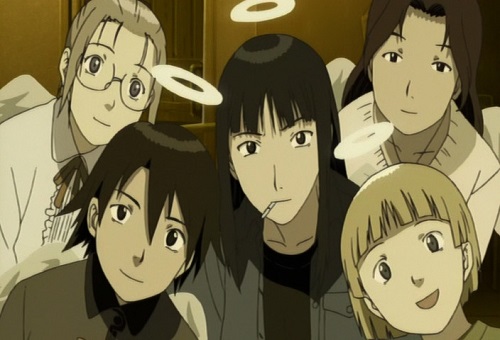
Characters
This brings me to the characters! While the story was simple and straight forward in its goals, an unornamented plate upon which the experience is served, the characters are the meal. How’s that for a food metaphor huh? What I’m saying is that the characters are anything but simple and they will be the primary focus of the story. These are not static people. Kuu, Kana, Nemu, Hyouko, all of them grow and change as the story progresses. However the main focus, the ones who get a vast majority of the screen time and development, are our leads Reki and Rakka. More than anyone else Haibane Renmei is their story. So while the rest of the cast is good, don’t expect their screen time to be balanced. I know I was a bit sad to see my girl Kana fade to the background a bit after her focus episode.
Sadly this is where I have to venture into spoiler territory if I want to have any kind of meaningful discussion about these two. If you haven’t seen the show yet, don’t read this. Seriously. Don’t. Read. The long story short is that these two are fantastic characters with great arcs that each affected me personally, albeit in different ways. Disclaimer out of the way, in we go!
First before we talk about Rakka and Reki we need to lay out Haibane Renmei’s metaphor of depression. This is the “Circle of Sin” and while I personally don’t like the label of “Sin” I’m willing to chalk it up to complex translation. At its core the Circle of Sin is this idea of self-acceptance and perpetuation. “To recognize Sin is to be free from sin”, sounds like a paradox right? But not to me. When I first heard this, and thought about it in reference to depression and self-hate, it felt more like it was telling me the first step. That until you recognize you have a problem, that you are hurting, that you need help, you cannot move forward. That the only way to address your sin, your depression, is to accept it exists in the first place but not to dwell on or let it define you.
With that lets move on to our lead, Rakka. This is who I meant previously when I mentioned “positive experiences” with religion. Throughout the story we see Rakka reaffirmed and supported by the Renmei. They answer her questions, give her structure and ultimately purpose in Glie. And in her darkest moment, at the bottom of a well of depression in both the literal and figurative sense, it is the Renmei who support her and get her out. She is also the one through whom we are first introduced to the Circle of Sin and the first to find the answer. She learns, through the bird, that she wasn’t alone in her previous life. That there was at least one person, the bird, who cared for and tried to save her. And in recognizing that, in recognizing this single loving connection, she becomes perfectly positioned to help our other lead, Reki.
In case you hadn’t put it together, Reki is the one with nothing but negative experiences. During her time in Glie the Renmei have only put more and more expectations on her. But rather than see those as attempts to help, at providing structure, Reki interprets them as mandates. She sees them as a set of rules laid down from on high. And that unless she conforms to them, unless she acts like a “Good Haibane” like the scripture Renmei tells her to she won’t be free. Reki sees this as a constraint rather than a suggestion. Combine that with her own issues of pushing people away, of feeling undeserving of love or friendship, and you can see how she becomes trapped in the riddle. And how Rakka, through experiencing it herself, is able to understand and connect with her. Is able to make her acknowledge that she is loved.
So what does all of this mean and why am I rambling on about it in the character section? Well its all setup for a bit of speculation on my part that will hopefully put my perspective in clear view. I viewed Glie as Limbo and the Haibane as children, or people in generally really, who committed suicide. That their dream in the cocoon is a representation of how they died, either by train or jumping off a building. And that their time in the city is meant to help them grow and confront those feelings, accepting, confessing and repenting for the “Sin” of suicide. All presented through a metaphor for lingering depression. This is why I think Haibane Renmei is religious. It’s why I think that the story and characters are simple, but with depth for those looking. And its why I really love and connect with these characters.
So yeah, that got a bit personal in there but that’s why I enjoy these characters. I think that for anyone who has ever experienced depression, who has questioned their worth, their stories hit home. And that with a little bit of empathy Haibane Renmei’s cast becomes a beautiful door to a subject most people are afraid to talk about or have little experience expressing. And for all its production woes, that’s worth experiencing. Despite some uh… slower pacing in the middle. That’s right I had to get at least one negative in all this gushing, the pacing can be a bit slow in the early Slice of Life segments. Sue me.
Audio
Jesus that got heavy! How about we talk about some music now? And what better place to start than with the man himself: Kou Ootani. This guy is incredible. Not only has he worked on the original Mobile Suit Gundam Wing and Outlaw Star he was also responsible for the hauntingly beautiful sounds of Shadow of the Colossus. And on a brief listen through his other works that seems to be a sort of calling card of his. These slow, grand, almost religious sounds pieces of music. Of course this is by no means his only genre. It does seem however to be something he enjoys and it fits Haibane Renmei like a glove. Take for instance the track “Ethereal Remains“. The imagery the soft bells, wordless vocals and childlike backing sounds evoke is, to me, nothing other than a church. And this powerful imagery is present throughout the ost.
On top of that Haibane Renmei makes fantastic use of reoccurring motifs. For example lets take a look at 3 of my favorite songs: “Ailes Grises“, “Garasu no Yume“, and “Nightmare~Parting~Loss“. The first is a purely instrumental piece, and a pleasant one at that. Growing in intensity as it slowly roller coasters it’s way up the scale, it’s one of the core melodies of Haibane Renmei. But now listen to “Garasu no Yume”. Can you hear it? That same rising and falling, only now accompanied by a voice, an active participant in the melody and story rather than simply listening along? And finally we have the third, a much more somber rendition. No more active singing. No more pleasant piano or whimsical, hopeful extra notes. Just a solemn close to the journey, slowly fading. Of course there are more examples but I don’t want to spoil the show through music.
Finally lets talk about the use of vocal tracks because Haibane Renmei has a lot of them. So far you have heard 2 such tracks, “Ethereal Remains” and “Garasu no Yume”. And both of those are great! But let me introduce you to a few more such as the ED, “Blue Flow” performed by, I believe, Aki Hata. An almost ethereal piece that really brings you into the otherworldly nature of the story. Or the character themes such as the elegant “Ashita e Modorou” for Nemu or the quiet and restrained “Mayoi no Kotori” for Rakka. There’s a quirky rendition of the motif I mentioned above in “Sora ni Arigatou” for Kuu. Anyways the point is that Haibane Renmei has a really good ost that fits its setting well. Maybe you aren’t interested in classical or chamber music, maybe you want something heavier. But for me? This is great.
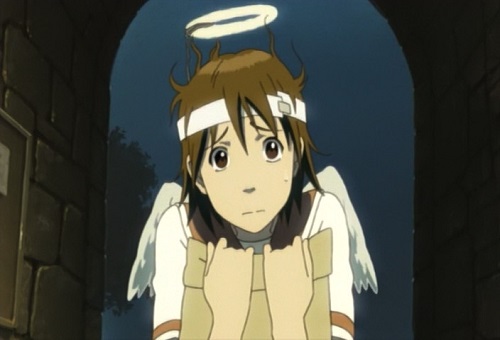
Managing Expectations
And with that the review is done and we arrive at the personal section of this review! This is basically my spot to sit, put down the reviewers hat and just talk about any old part of the show I felt was important. This isn’t particularly structured. There will be spoilers. If that doesn’t interest you, then skip! This has no effect on my final score. But if you want to try and understand me a bit more before you see my conclusion, read on!
For those of you that have followed me for awhile you might be aware that I recently reviewed a show called Sonny Boy. For those that aren’t the long and short of it is this: I really really did not like that show. And I didn’t like it because it felt like a mess, like there wasn’t a clear vision behind it. That Sonny Boy just kept adding more and more things without any care for how they all fit together, that it asked questions with no intention of answering. Hearing that you might be surprised, and understandably confused, as to why I enjoyed Haibane Renmei so much. Well the answer is simple: Haibane Renmei properly managed my expectations.
What does that mean? To make it simple, it means I never felt like there was an unresolved Chekov’s Gun situation. I never felt like Haibane Renmei introduced me to a concept, made me think it was important, and then never elaborated on it. Of course there are things such as the Walls, the Renmei, the Tags, etc. There are plenty of things that Haibane Renmei doesn’t explain. But the difference between them for me is that the Walls, the Renmei, the Tags, they were never the focus. Even in the episodes they were introduced or partially explained in, it was always done as a backdrop to Reki and Rakka’s story. And that story always stayed safely confined to the walls of Glie. It never made me ask “What was beyond the walls” because I never thought we would go beyond them.
Contrast that to Sonny Boy where every episode seemed to introduce a new concept. Whether it be traversing worlds, the rules or rewards of those worlds or the society the kids had built up between worlds, there were plenty of things to explore. And explore Sonny Boy did! It often talked about the rules or introduced worlds as the primary focus of the episode. It built entire character dynamics around the rule of the world it was taking place in. But as the show progressed it never answered any of the questions it asked. It only every introduced more… and more… and more… and eventually I got fatigued. I stopped caring about the worlds, the rules or the kids.
Anyways I didn’t start this to clown on Sonny Boy so lets get back to Haibane Renmei. Because the bounds of the story were set so clearly so early on it allowed me to stay focused on what mattered. My mind never wondered to beyond the walls or the ancient past. It stayed rooted on Reki and Rakka. Of course it hinted at some things, such as the fate of Haibane who don’t have their Day of Flight, and we saw glimpses of something more such as the spirit within the Wall or the tags. And I can definitely say I wish some of those were expanded on more, I think they were a missed opportunity. But they are so far removed from Reki and Raka that I can’t find it in me to be that upset about them. It’s just a good show.
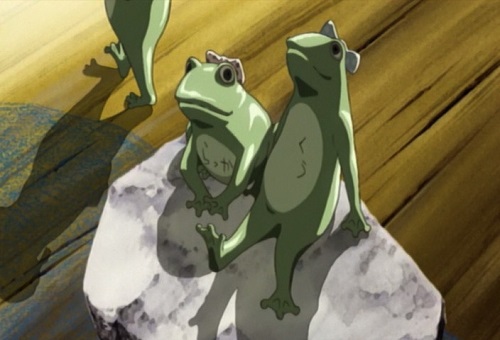
Conclusion
All in all, how was Haibane Renmei? Does it have it’s issues despite my personal gushing? Would I recommend you watch it in spite of that? The answer to those are “Very”, “Yes” and “Of course”. Haibane Renmei isn’t a perfect series. Sometimes its visuals suck while other times its evocative and haunting. Sometimes a specific arc or story can go on for one episode to long and I start to feel like we’ve lost the main thread. But the in the episode right after that we get back on track and I can’t help but care about these little bird girls. So yeah. Please watch Haibane Renmei. And if it affects you in the ways it affected me, please let me know. I love hearing that people actually read these.
See you next time!
And that’s a wrap! Thanks for sticking around for another season, I hope you enjoyed readin what this fool had to say. But enough about Haibane Renmei, you know what time it is. Time to announce our next season of Throwback Thursday! And the winner is, after losing by just 1 vote in the last poll…. Vision of Escaflowne! Directed by Kazuki Akane, created by Shouji Kawamori and animated by Studio Sunrise, we are returning the the land of Mecha! Fuck… when was the last time I watched a mecha? Does Eighty Six count? Someone let me know because if it doesn’t its been a loooooong time. Now because of its 26 episode length we will be doing 2 episodes a week starting on November 11th! Hope to see you there.

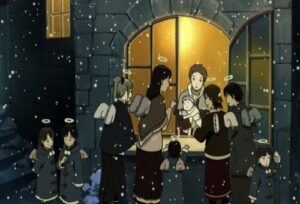
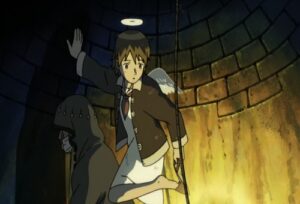


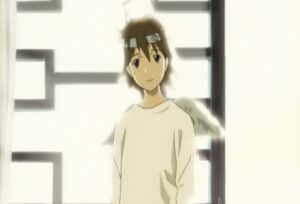
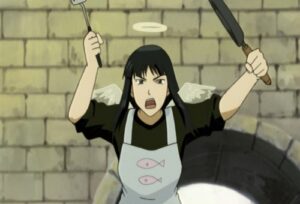
Glad to see you enjoyed Haibane Renmei! Which reminds me, I really need to rewatch it and review it for myself, seeing as it’s one of my favorite anime of all time. Your review has a lower rating than Psgels’ review of it, but is considerably more detailed and elaborate. Nothing wrong with that, as it’s nice to see two peoples’ different views on something, as you can glean different things from both. And super stoked to read about your watching of Escaflowne (Dilandau’s my favorite anime villain of all time).
I really did like Haibane. But I just couldn’t bring myself, with its production and some of the middle pacing, to place it up with/above other supreme favorites of mine like Perfect Blue, Mushishi, etc. Its on the cusp. Its a good show that I connected with. But it’s not something thats easily digestible/bingeable/I can pick it up and watch it any time like I can with others, if that makes sense.
Like I don’t think 85+ is a bad score personally. And I hope what I wrote backs that up.
For me, Haibane Renmei is about making sense of the world and finding one’s place in it, however hard it may be.
Haibane Renmei wasn’t the first anime I watched, but it is single-handedly responsible for making me an anime fan (I’m up to 513 completed series on MyAnimeList and the counter has been stuck for years since the API was disabled).
It’s scary to think it’s going to be twenty years old this time next year.